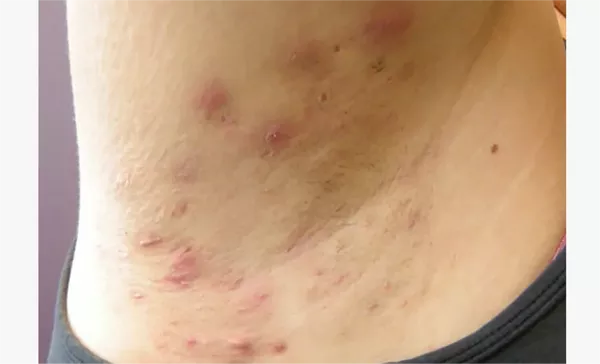Hidradenitis suppurativa (HS) is a chronic inflammatory skin condition characterized by painful lumps, abscesses, and scarring, predominantly affecting areas where skin rubs together such as the armpits, groin, and under the breasts. Its exact cause remains unclear, but it is believed to involve a combination of genetic, hormonal, and environmental factors. Managing HS, particularly in the armpits, can be challenging due to the area’s constant movement and friction. However, a combination of medical treatments, lifestyle adjustments, and home care strategies can significantly alleviate symptoms and improve quality of life for those affected.
Understanding Hidradenitis Suppurativa
HS often begins after puberty, with women being more commonly affected than men. The disease is marked by periods of flare-ups and remission, and its severity can vary widely among individuals. HS in the armpits can be particularly debilitating due to the constant use and friction in this area, which exacerbates the symptoms.
Medical Treatments for Hidradenitis Suppurativa
1. Antibiotics
Antibiotics are often the first line of treatment for HS, particularly during the early stages of the disease. They can help reduce inflammation and prevent secondary bacterial infections. Topical antibiotics, such as clindamycin, are commonly prescribed for mild cases, while oral antibiotics like tetracycline, doxycycline, and minocycline are used for more severe cases. Long-term use of antibiotics can be necessary to keep symptoms under control, although this approach carries the risk of developing antibiotic resistance.
2. Anti-inflammatory Treatments
Non-steroidal anti-inflammatory drugs (NSAIDs), such as ibuprofen, can help reduce pain and inflammation associated with HS. In more severe cases, corticosteroids may be prescribed. Corticosteroids can be administered topically, orally, or through injections directly into the affected areas to reduce inflammation and promote healing.
3. Hormonal Therapy
Since hormonal fluctuations can influence HS, hormonal therapy can be effective, particularly for women. Treatments may include oral contraceptives, anti-androgen medications like spironolactone, or other hormonal therapies to regulate hormonal imbalances and reduce flare-ups.
4. Biologics and Immunosuppressants
For moderate to severe HS, biologic therapies, such as tumor necrosis factor (TNF) inhibitors (e.g., adalimumab), have shown promising results. These medications work by targeting specific components of the immune system to reduce inflammation. Immunosuppressants like cyclosporine may also be considered for their ability to dampen the overactive immune response in HS.
5. Surgical Interventions
In cases where medical treatments are insufficient, surgical options may be explored. These can range from minor procedures to drain abscesses to more extensive surgeries such as wide excision, where affected tissue is removed to prevent recurrence. Laser therapy and carbon dioxide laser surgery are also options to destroy affected glands and reduce scarring.
Lifestyle Adjustments and Home Care
1. Hygiene and Skin Care
Maintaining proper hygiene is crucial in managing HS. Gentle cleansing of the armpits with mild, antibacterial soap can help reduce bacteria and prevent infections. Avoiding harsh soaps and scrubbing is important to prevent irritation. After washing, the area should be patted dry gently with a clean towel.
2. Clothing Choices
Wearing loose, breathable clothing made from natural fibers such as cotton can help reduce friction and moisture buildup in the armpits. Tight clothing and synthetic fabrics should be avoided as they can exacerbate irritation and sweating.
SEE ALSO: What Bacteria Causes Hidradenitis Suppurativa
3. Weight Management and Diet
Obesity is a known risk factor for HS, and weight management can play a significant role in reducing symptoms. A balanced diet rich in fruits, vegetables, lean proteins, and whole grains can support overall health and reduce inflammation. Some studies suggest that eliminating dairy and high-glycemic foods may also help reduce flare-ups, although more research is needed in this area.
4. Stress Management
Stress is a known trigger for HS flare-ups. Techniques such as mindfulness, meditation, yoga, and regular physical activity can help manage stress levels. Finding healthy outlets for stress and maintaining a support network can also be beneficial.
Advanced Home Care Strategies
1. Warm Compresses
Applying warm compresses to the armpits can help soothe pain and promote drainage of abscesses. This should be done for 10-15 minutes several times a day, using a clean cloth soaked in warm water.
2. Topical Treatments
Topical treatments, including over-the-counter options like antiseptic solutions (e.g., chlorhexidine) and prescription-strength creams (e.g., retinoids), can help reduce bacteria and promote healing. These should be used as directed by a healthcare provider.
3. Pain Management
Over-the-counter pain relievers such as acetaminophen or ibuprofen can be used to manage pain during flare-ups. For more severe pain, prescription pain medications may be necessary under the guidance of a healthcare provider.
4. Smoking Cessation
Smoking is a significant risk factor for HS. Quitting smoking can lead to a reduction in flare-ups and improve overall health. Support groups, counseling, and smoking cessation programs can provide the necessary tools and support to quit successfully.
Psychological and Emotional Support
Living with HS can be emotionally and psychologically challenging. Chronic pain, discomfort, and the visible nature of the disease can lead to feelings of embarrassment, isolation, and depression. Seeking support from mental health professionals, joining support groups, and connecting with others who have HS can provide emotional support and coping strategies. Cognitive-behavioral therapy (CBT) and other therapeutic approaches can help manage the psychological impact of the disease.
Future Directions in HS Treatment
Research into HS is ongoing, and future treatments may offer more effective and targeted options. Advances in genetic research may provide insights into the underlying causes of HS, leading to more personalized treatment approaches. Novel therapies, including new biologic agents and advanced surgical techniques, are being explored to improve outcomes for patients.
Conclusion
Managing hidradenitis suppurativa in the armpits requires a comprehensive and individualized approach. Medical treatments, lifestyle adjustments, and home care strategies all play crucial roles in reducing symptoms and preventing flare-ups. By working closely with healthcare providers and adopting a proactive approach to care, individuals with HS can achieve better control over their condition and improve their quality of life. While HS remains a challenging condition, ongoing research and advances in treatment offer hope for more effective management in the future.
Related Topics:



























